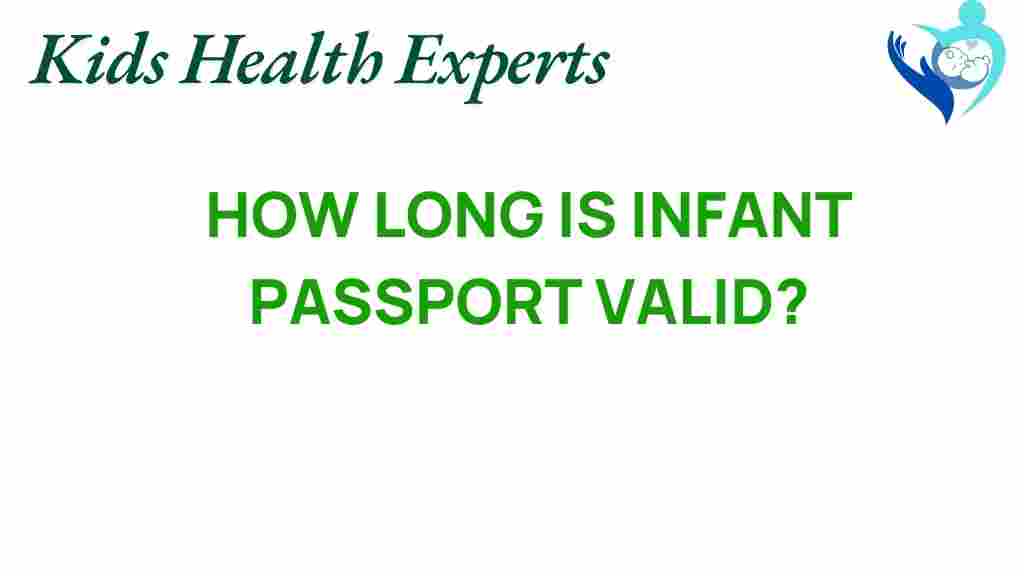The Surprising Duration of Infant Passport Validity Explained
As parents, embarking on international travel with your little one can be both exciting and daunting. One of the key aspects of planning your trip is understanding the infant passport rules, particularly the duration of passport validity. This article will guide you through everything you need to know about passport validity for infants, vital travel tips for child travel, and essential travel documents to ensure a smooth journey.
Understanding Infant Passport Validity
When it comes to infant passports, many parents are surprised to learn about the specific rules governing their validity. Typically, an infant passport is issued for a duration of five years, which is shorter than that of adult passports, which are valid for ten years. Here’s a breakdown of what you need to know:
- Duration: Infant passports are valid for five years from the date of issue.
- Renewal: Before your child’s fifth birthday, you will need to renew their passport.
- Photo Requirements: Passport photos for infants must meet specific guidelines, including size, background, and expression.
- Application Process: The process for obtaining an infant passport can differ from that of adults, often requiring both parents’ consent.
Why is the Validity Period Shorter?
The shorter duration of infant passports is primarily due to the rapid growth and changes that infants undergo. A child’s appearance can change significantly in just a few years, making older photos less representative. This ensures that the passport remains a reliable form of identification throughout its validity.
Step-by-Step Process to Obtain an Infant Passport
Obtaining a passport for your infant may seem overwhelming, but following this simple step-by-step guide will make the process much easier:
Step 1: Gather Required Documents
<pBefore applying for an infant passport, make sure you have the following documents ready:
- Proof of U.S. citizenship (e.g., a birth certificate).
- Proof of parental relationship (e.g., the same birth certificate).
- Parental identification (e.g., driver’s license or passport).
- A completed Form DS-11 (the application for a U.S. passport).
- One passport photo of the infant that meets the official requirements.
Step 2: Complete the Application Form
Download and complete Form DS-11 from the official U.S. State Department website. Ensure all sections are filled out accurately, as errors can delay processing.
Step 3: Make an Appointment
You must apply for an infant passport in person at an authorized passport acceptance facility. Schedule an appointment ahead of time, as walk-ins may not be accommodated.
Step 4: Attend the Appointment
During the appointment, both parents or guardians must be present with the infant. Bring all required documents and payment for the application fee, which varies based on the type of passport service requested.
Step 5: Track the Application
After submitting the application, you can track its status online. Typically, the processing time is around 8 to 11 weeks, so plan accordingly.
Travel Tips for International Travel with an Infant
Traveling internationally with an infant requires careful planning. Here are some essential travel tips to ensure a hassle-free experience:
1. Plan Ahead
Make arrangements for flights, accommodations, and transportation well in advance. Many airlines offer special services for families traveling with infants, so inquire about their policies.
2. Pack Smart
When packing for your baby, consider the following:
- Essentials like diapers, wipes, and a change of clothes.
- Comfort items like a favorite blanket or toy.
- Medications and health documents.
3. Keep Travel Documents Handy
Always keep your child’s passport and other travel documents within easy reach. A travel wallet can help keep everything organized.
4. Prepare for Security Checks
Be prepared for security checks at the airport. You may need to hold your infant while their stroller or carrier goes through the scanner.
5. Choose Accommodations Wisely
Look for family-friendly accommodations that provide amenities like cribs, high chairs, and kitchen facilities to make your stay more comfortable.
Common Troubleshooting Tips for Parents
Even with careful planning, issues can arise during your travel experience. Here are some common problems and how to address them:
Problem: Passport Processing Delays
Solution: If you notice that your infant’s passport application is taking longer than expected, check the status online. If it exceeds the standard processing time, contact the passport agency directly for assistance.
Problem: Lost Passport
Solution: If your infant’s passport gets lost or stolen while traveling, report it to the local authorities and the nearest embassy or consulate immediately. They can guide you on obtaining an emergency passport.
Problem: Health Issues Abroad
Solution: Before traveling, consult your pediatrician about potential health concerns in your destination country. Keep a list of local hospitals and clinics handy.
Conclusion
Understanding the rules surrounding infant passport validity and preparation can ensure a more enjoyable travel experience for you and your child. By following the steps outlined in this article, you can navigate the complexities of travel documents and international travel with ease. Remember, preparation is key to a successful trip with your little one.
For more parenting advice and travel tips, be sure to check out our comprehensive guide on family travel. Happy travels!
For additional information on passport rules and updates, visit the U.S. State Department website.
This article is in the category Growth and created by KidsHealthExperts Team
